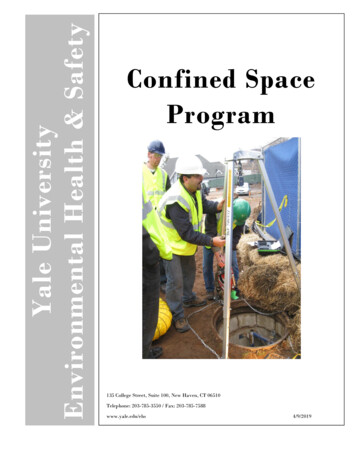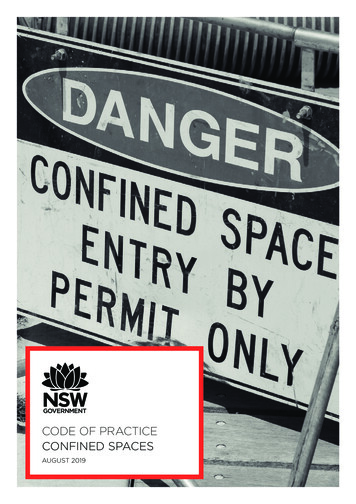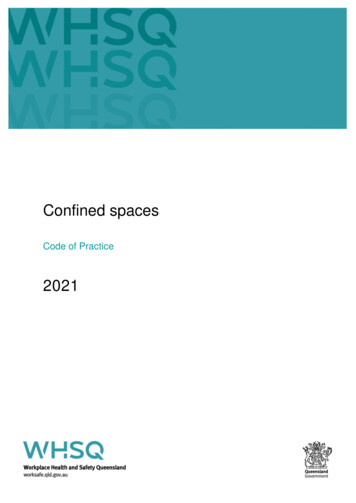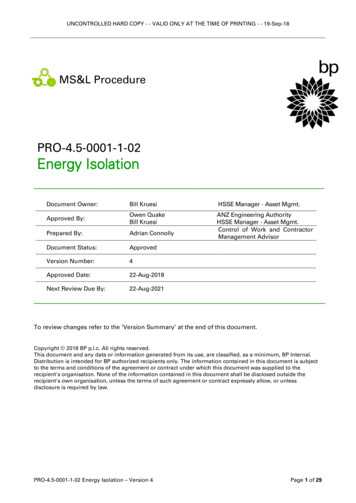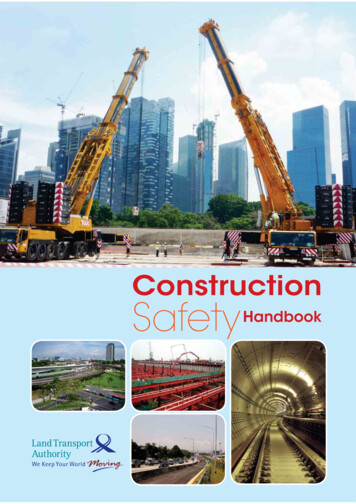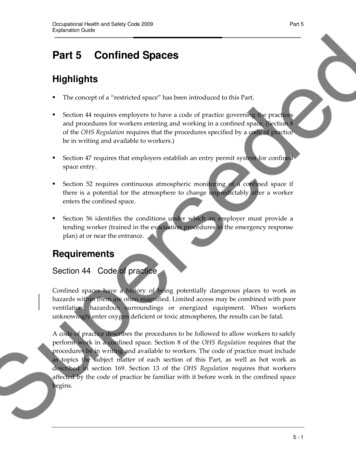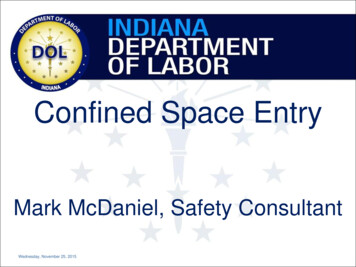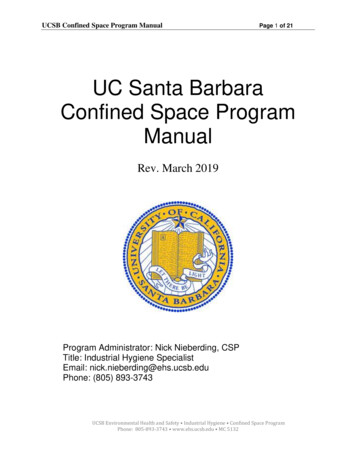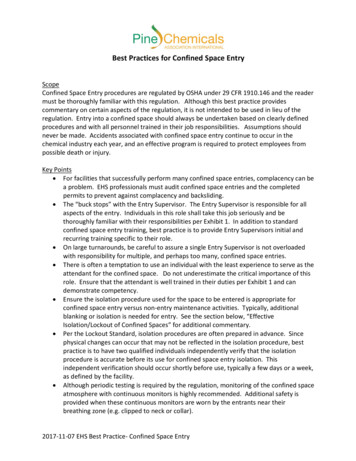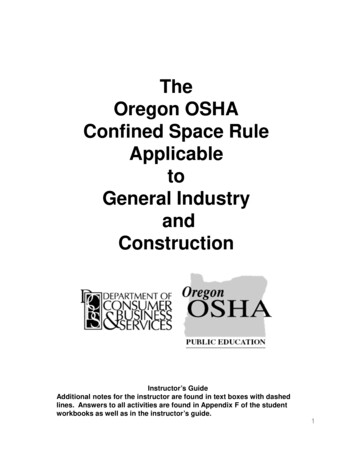
Transcription
TheOregon OSHAConfined Space RuleApplicabletoGeneral IndustryandConstructionInstructor’s GuideAdditional notes for the instructor are found in text boxes with dashedlines. Answers to all activities are found in Appendix F of the studentworkbooks as well as in the instructor’s guide.1
Please NoteThis material, or any other material used to inform employers of compliancerequirements of Oregon OSHA standards through simplification of the regulations shouldnot be considered a substitute for any provisions of the Oregon Safe Employment Act orfor any standards issued by Oregon OSHA.Notes for the instructor for this class are found in text boxes with dashed lines. Answersto all activities are found in Appendix F of the Student Workbooks as well as in theInstructor’s Guide.In addition to this workbook, guidance is available in the form of materials on the OregonOSHA website www.orosha.org, and through Oregon OSHA Consultation.2
ContentsWorkbookIntroductionPurpose and ApplicationWhat is Not Covered?DefinitionsWhat is a Confined Space?What is a Permit-required Confined Space?Hazard EvaluationIdentifying Permit-required Confined Spaces with SignsEntering a Permit-required Confined SpaceEmployees Do Not EnterEntry with a PermitAlternate EntryMulti-employer WorksitesRecordsPage 4Page 5Page 6Page 8Page 9Page 12Page 13Page 18Page 19Page 20Page 21Page 35Page 40Page 41AppendicesA-OAR 437-002-0146 Confined SpacesB-Highlights of Amendments to the Oregon OSHA RuleC-Completed Entry Permit and Alternate Entry FormD-Case Studies From Accident InvestigationsE-ResourcesF-Answer Key to Workbook Activities3
IntroductionThe objective of this class is to raise the awareness level of attendees regardingpractices intended to protect workers from the hazards of working in a confined space.This will be accomplished through the use of discussion, activities and resourcesincluding the Oregon OSHA Confined Space Rule applicable to General Industry andConstruction, OAR 437-002-0146.But what is our real goal? To save lives—maybe a co-worker or an employee, certainlysomeone’s son or daughter. We have all heard of fatalities related to confined spacework that included the people who originally entered the space and also the person orpersons who tried to rescue them. It is because of this grim reality that Oregon OSHAhas developed the Confined Space Rule.4
Purpose and ApplicationWhat is the purpose of this rule?The purpose of this rule is to provide requirements to protect employees from thehazards of entering and working in confined spaces.Who does this rule apply to?OAR 437-002-146 applies to the state of Oregon. It covers all activities in confinedspaces for employers covered by the Oregon OSHA regulations for General Industry(Division 2) and Construction (Division 3).It is not the Federal OSHA standard 29 CFR 1910.146.When does this rule go into effect?The rule amendments are effective as of January 1, 2015 for General Industry, and forConstruction on March 1, 2015.5
What is Not Covered?Pipe in ExcavationActivity:Look at the photos in thissection. Are they ofexempted activities?Why or why not?Some work may appear to be coveredby the Confined Space Rule, but isactually covered by another rule:(a) Construction work regulated byDivision 3/P Excavations, except forentry into sewer spaces that are largeenough to bodily enter.(b) Construction work regulated byDivision 3/S Underground Construction,Caissons, Cofferdams and CompressedAir, except for sewers.(c) Enclosed spaces regulated by1910.269 in Division 2/R Electric PowerGeneration, Transmission AndDistribution, except when that standardrequires compliance with this standard.(d) Enclosed spaces regulated by1926.953 in Division 3/V Electric PowerGeneration, Transmission AndDistribution, except when that standardrequires compliance with this standard.(e) Manholes and vaults regulated by1910.268(o) in Division 2/RTelecommunications, unless the spacecannot be made safe to enter even afterfollowing the requirements of1910.268(o).6
What is Not Covered?Welding DuringTank Construction(f) Welding in confined spacesregulated by Division 2/Q Welding,Cutting & Brazing, when the onlyhazards are related to the weldingprocess.(g) Grain bins, silos, tanks, and othergrain storage structures regulated by1910.272, Grain Handling Facilities.(h) Diving operations regulated byDivision 2/T, Commercial DivingOperations.(i) Except for (a) through (h) above,when any other applicable standardaddresses work in confined spaces oradditional hazards that may bepresent, you must comply with theprovisions of that standard and thisstandard. Where the requirements ofone standard are more restrictive thanthe other, follow the more stringentrequirements.Grain ElevatorHeadworks7
Are there words in the rule withspecific definitions? Yes!They can be found in Section 3 of therule, which is located in Appendix Aof this workbook.8
What is a Confined Space?It is a space that meets all of the following requirements:Large enough and shaped so someone can fully enter and do workANDEntry and/or exit is limited or restrictedANDIs not designed for continuous human occupancyActivity:Identify the confined spaces in the following photos.Sport Utility VehicleInstructor: Confined spaces can be inside, outside, on top of and underneath a building, and can be apiece of machinery, including mobile units. Walk around! In Construction, who is responsible for performing this evaluation? This is answered inSection 4 of the Confined Space Rule.9
What is a Confined Space?PlasticTanksWelding DuringTank ConstructionCementMixerCement MixerDrum10
What is a Confined Space?FermentationTankProduceWasherManholein ExcavationUndergroundUtility Tunnel11
What is a Permit-requiredConfined Space?It is a confined space with a hazard as explained below:Have or could have ahazardous atmosphereContains a materialthat could trap or buryIs shaped so a person couldbe trapped or asphyxiatedHas any other recognizedserious safety or health hazard12
Hazard EvaluationIn the Confined Space Rule there are two main types of hazards: physical andatmospheric. They may be present or have the potential to be present. Prior to entry,hazards should be anticipated, identified, evaluated, and eliminated if a physical hazard,and controlled or eliminated if an atmospheric hazard.A physical hazard is defined as an existing or potential hazard that can cause: Death Serious physical harmIt includes but is not limited to: Explosives Mechanical, electrical, hydraulic and pneumatic energy Radiation Temperature extremes Engulfment Noise , if it prevents the ability to communicate or hear warnings Inwardly converging surfaces Chemicals that can cause death or serious physical harm through skin oreye contact, rather than by inhalation13
Hazard EvaluationAn atmospheric hazard is an existing or potential atmosphere that may exposeemployees to the risk of: Death Incapacitation Impairment of ability to escape without help Injury Acute illnessAs a result of one or more of the following conditions: A flammable gas, vapor, or mist in excess of 10 percent of its lowerflammable limit An airborne combustible dust An atmospheric oxygen concentration below 19.5 percent or above 23.5percent (oxygen deficiency and oxygen enrichment) An airborne concentration of a substance that exceeds the dose orexposure limit specified by an Oregon OSHA requirement (dust thatobscures vision at a distance of 5 feet is included) An atmosphere that presents an immediate danger to life or health (IDLH)In other words, any atmosphere that could result in death or serious injury to aworker as caused by oxygen deficiency or enrichment, toxic materials, andflammable or explosive materials. The emphasis is on acute hazards, notchronic.14
Hazard EvaluationTo anticipate and identify, check historical information such as accident investigations,OSHA 300 Logs, Workers’ Compensation claims, worksite inspections and Safety DataSheets (SDS). Consider injury and illness data from sources such as the OregonOccupational Safety and Health Administration (Oregon OSHA), The National Institute ofOccupational Safety and Health (NIOSH), the Oregon Institute of Occupational HealthSciences (OIOHS) and trade or professional associations, if available.To evaluate, measure the hazard with a device, such as a gas meter or other directreading instrument. Conform or compare to set standards where acceptable andunacceptable conditions have been determined, such as Oregon OSHA’s Division 2/SubZ Toxic and Hazardous Substances Rule Permissible Exposure Limits (OSHA PELs),National Institute of Occupational Safety and Health Recommended Exposure Limits(NIOSH RELs), the American National Standards Institute (ANSI), or the AmericanCongress of Governmental Industrial Hygienists Threshold Limit Values (ACGIH TLVs).To eliminate or control, remember that elimination removes the source of the hazard,while a control is a means to prevent or reduce exposure to the hazard. For the purposeof this rule, removal of the source of the hazard and isolation are considered elimination,with lockout being an example. Engineering controls such as mechanical ventilation areconsidered control measures. Personal protective equipment, such as respirators, arenot considered engineering control measures.15
Hazard EvaluationActivity:Can this four-gas monitor be used to measureall atmospheric hazards?Why or why not?What can it measure?16
Hazard EvaluationActivity:Under what conditions would the confined spaces shownbelow be permit-required confined spaces?Manhole in ExcavationCement MixerTankCement Mixer Drum17
Identifying Permit-RequiredConfined Spaces with SignsYou must have a way for employees to recognize your permit-required confinedspaces. In addition to training, you can use signs, labels or tags.The rule does not require each space to have its own sign—it’s acceptable to identify agroup of similar spaces, such as manholes, in a general way.18
Entering a Permit-RequiredConfined SpaceAfter you have identified and evaluated your permit-required confined spaces, you’llneed to make some decisions about how those spaces will be entered. What areyour options for entering a permit–required confined space?In Oregon, under Oregon OSHA standard OAR 437-002-0146, you have thefollowing options:If you havethis Permit-RequiredConfined SpaceThen these areyour options Employees donot enterPermitRequired EntryAlternate Entrywhen allowedAnd this is whatyou’ll do Hire aContractor?Follow allrequirementsfor permitrequired entryFollow allrequirementsfor alternateentryWe will look at the requirements for each option in the order they appear.InstructorThe Federal OSHA standard 29 CFR 1910.146 allows the following: Employees do not enter (ultimately, a contractor is usually hired) Full permit entry Reclassification when only a physical hazard is present (for example, for hazardousenergy use lockout/tagout) Alternate entry when only an atmospheric hazard is present (test and use forced-air19ventilation continuously)
Entering a Permit-required Confined SpaceEmployees Do Not EnterWhat are your responsibilities if you decide your employees will not enter your permitrequired confined spaces?Your employees must know how to identify your permit-required confined spaces, andthat they are not allowed to enter.If you have someone else enter your permit-required confined spaces, such as acontractor, then you are required to provide them any information you have about thehazards of the space (e.g. why you consider the space to be a permit-required confinedspace). More information on this topic will be provided in a later section of thisworkbook, Multi-employer Worksites.20
Entering a Permit-required Confined SpaceEntry with a PermitTo enter a permit-required confined space with a full permit, do or have the following.The corresponding paragraphs in the Confined Space Rule are found in parentheses: Evaluations (4) Permit-required confined space written entry program and permits (5) Permit entry procedures (6) Equipment (7) Personnel (8) Rescue (9) Training (11) Multi-employer worksite procedures (12) Records(13)21
Entering a Permit-required Confined SpaceEntry with a Permit - Written Program and PermitsWhat must be included in the written program? The full list of requirements is found onpage J-9 of the rule, which is included as Appendix A of this workbook, but here is apartial summary: Develop and implement a written program that describes the means, practices, andprocedures to safely identify and enter those spaces. On fixed sites, also include a catalog of the locations of all permit spaces, and thereasons why they are permit spaces. A group of similar spaces, such as manholes,can be identified in a general way. Ensure employees and their representatives have access to the written program.As a best practice for construction, you may wish to develop a written program that canbe tailored to the different potential sites you might encounter in your line of business,well in advance of any actual entry. Also, many general contractors requiresubcontractors to have a written program.There are requirements in the program for managing permits, also. Within one year oftheir cancellation date, all permits must be reviewed to evaluate the program. Also, theprogram must be reviewed and revised if there is reason to believe employees are notadequately protected. Situations that require this review include unauthorized entry of apermit-required space, and any injury or near-miss during entry.22
Entering a Permit-required Confined SpaceEntry with a Permit - ProceduresYou must have the following in place to enter a permit space:1.Entry permits that include the following information:The space to be enteredThe purpose of the entryThe date, start, and stoptimes of the permitThe hazards of the spaceAcceptable entry conditionsResults of initial tests andperiodic monitoring, or theperiod for continuousmonitoring, and the names orinitials of the testers andwhen the tests wereperformedMeasures to isolate thespace and eliminate orcontrols hazards before entryNames of entrants andcurrent attendantsSignature of the originalsupervisor authorizing entryCurrent entry supervisorCommunication procedures forentrants and attendantsEquipment provided for entryRescue services available andhow to contact themOther information needed forsafetyAdditional permits for work in thespace, such as for hot workAny problems encountered duringentry23
Entering a Permit-required Confined Space2.3.4.5.6.7.8.Procedures for issuing permitsTesting for atmospheric hazards before entryProvide results of atmospheric testing to entrantsMaintain safe entry conditions for the duration of the entryFollow all actions and precautions on the permitIf you have to evacuate, re-assess the conditions of the space to ensure it issafe for re-entry and ensure the permit reflects the evacuation and subsequentre-assessment. Another option is to issue a new permit.Allow entrants to observe monitoring, testing, and any other actions taken toeliminate or control hazardsThere is an example of a blank entry permit in the Confined Space Rule, found inAppendix A of this workbook. There is also an example of a completed entry permit,in Appendix C of this workbook.InstructorAir monitoring is performed before entry and then periodically. If monitoring continuously,record peaks.24
Entering a Permit-required Confined SpaceEntry with a Permit - EquipmentAll equipment must be maintained and used in accordance with the instructions from themanufacturer. For example, if the manufacturer’s directions say to perform a factorycalibration, then that’s what you need to do.Bump testing of air monitoring equipment is recommended prior to every use. Keep inmind that a bump test confirms that the monitor reads a given substance, as opposed tozeroing, which means nothing is detected.Provide all necessary equipment at no cost to your employees. Ensure all employeeswho use equipment are trained to do so.25
Entering a Permit-required Confined SpaceActivity:Name the types of equipment in the picturesInstructor You must follow the requirements of the Respirator Standard Follow all requirements in the respirator standard about egress bottles Emergency Respirators must be inspected monthly, and the documentation must stay with therespirator; Escape Respirators must be inspected before they are carried into the workplace.26
Entering a Permit-required Confined SpaceEntry with a Permit - PersonnelWhat are the roles and training requirements for personnel involved with a permitrequired entry?Entrants must: Know about hazards that they may face during entry and the signs, symptomsand consequences of exposure Communicate with the attendant so the attendant can monitor their status andwarn them when they need to evacuate Alert the attendants about hazardous conditions in the space or symptoms ofexposure Exit the space immediately when: An order to evacuate is given by the attendant or the entry supervisor An entrant recognizes any warning sign or symptom of exposure to adangerous situation An entrant detects a dangerous or hazardous condition An evacuation alarm is activated27
Entering a Permit-required Confined SpaceAttendants must: Know the hazards entrants may face during entry and the signs, symptoms,and consequences of exposure Be aware of the behavioral effects of hazards on entrants Keep an on-going count of entrants and ensure that the count identifies whois in the space Remain outside the space during entry operations until relieved by anotherattendant Communicate with entrants to monitor their status and to alert them if theyneed to evacuate Monitor activities inside and outside the space to determine if it is safe forentrants to remain in the space. Order entrants to evacuate immediatelyunder the following conditions: A dangerous or hazardous condition is detected If the behavioral effects of hazard exposure are detected If there is a dangerous situation outside the space If the attendant cannot perform all required duties Summon emergency services as soon as entrants need to escape from thespace Warn unauthorized persons to stay away if they approach the space; tellthem to leave immediately if they enter the space; and inform the entrantsand entry supervisor if unauthorized persons have entered the space. Perform non-entry rescues following your established rescue procedure Do nothing that would interfere with monitoring and protecting an entrant(note: even while monitoring another space.)28
Entering a Permit-required Confined SpaceEntry Supervisors must: Know the hazards that entrants may face during entry, including the signs,symptoms, and consequences of exposure Understand how to control or eliminate hazards associated with the space Verify, by checking that the appropriate entries have been made on thepermit, that all tests specified by the entry permit have been conducted andthat all procedures and equipment specified by the permit are in place beforesigning the permit and allowing entry to begin Inform entrants and attendants about the hazards and conditions associatedwith the space and the methods used to eliminate or control the hazards Terminate the entry and cancel the entry permit as required by the entryprocedures Verify that rescue service providers are available and that they can becontacted in an emergency Remove unauthorized individuals who enter or attempt to enter Reevaluate the conditions within the space whenever responsibility for apermit space entry operation is transferred and at intervals dictated by thehazards and operations performed within the space.29
Entering a Permit-required Confined SpaceEntry with a Permit - RescueWhat are your options for performing rescue? If workers cannot evacuate withoutoutside help, then these are your options:Non-entry rescueThis means nobody beyond theentrant goes in. It also typicallymeans the entrant is wearing aharness that is attached to aretrieval device that is designed toallow them to be pulled them out ofthe space by somebody else, suchas the attendant.Entry rescueThis means somebody goes in. Theymust have equipment and training,and follow all requirements in the rule.30
Entering a Permit-required Confined SpaceThird-party rescueThis means somebody elsegoes in, with whom you havemade arrangements to doso. The third-party mustfollow entry requirements.Simply planning to rely on911 services does not meetrequirements of the rule.Whatever option you choose, rescue procedures must include :– A process for summoning rescue services– A process for summoning emergency medical services or transporting injuredentrants to a medical facility.– A way for the Safety Data Sheet (SDS) or other similar written information bekept at the worksite, and be made available to the medical facility treating anexposed entrant.– They must also have practiced performing a rescue before the entry, but nomore than 12 months before.31
Entering a Permit-required Confined SpaceThe rescue team must have access to the spaces before the entry because they need todevelop a rescue plan and practice before the actual entry. If the team has access to aspace similar in size, configuration and accessibility to the one that needs to be entered,they can use that space for the practice rescue instead.When your workers are mobile, they do not need to do the annual practice (either entryor non-entry) if the rescue team does a practice rescue in the space that needs to beentered, before the actual entry.32
Entering a Permit-required Confined SpaceWhat about the fire department? In most cases, fire departments do notprovide rescue services. If they do , they must follow the same requirementsas any third-party rescue provider. For more information, see the ConfinedSpace Rule, Non-Mandatory Appendix D - Rescue ConsiderationsActivity:Can a space be modified to make rescuesafer or easier?33
Entering a Permit-required Confined SpaceEntry with a Permit - TrainingTrain employees involved in permit space activities so they have the understanding,knowledge, and skills necessary to safely perform their duties.Training is required: For all new employees Before an employee is assigned permit-space duties Before there is a change in an employee’s assigned duties When there is a hazard for which an employee has not been trained When there are changes to the permit program When the permit audit shows deficiencies When there is a deviation from established procedures or an employee’s knowledgeof the procedures is inadequateAwareness training is required for employees who work or may work in areas wherepermit spaces are present. It must explain the permit-space program, the entry permitsystem, the alternate entry procedures, if used, and how to recognize permit spaces intheir work area. It provides a basic overview of the permit space program.Repeat training when there is a change in the written program and when there are newor previously unidentified permit spaces.Record each employee’s training, including the employee’s name, the trainer’s signature,the training date, and the employee’s responsibilities. Employees must be able toinspect their training records.InstructorIf the company identifiesa new permit-requiredconfined space, affectedemployees must beretrained at theawareness level.34
Alternate EntryAlternate entry is a specific procedure for entering a permit space without a full permit.Alternate entry procedures vary from permit entry procedures in several significant ways.For example: an attendant is not required; rescue procedures are not required; and thereare fewer documentation requirements.The following sections of the rule apply. The corresponding paragraphs in the ConfinedSpace Rule are found in parentheses: Evaluations (4) Equipment (7) Alternate entry procedures (10) Training (11)You need to do the following: Eliminate all hazardsOR Eliminate all physical hazards in the space and control all hazardousatmospheres with continuous ventilation35
Alternate EntryYou need to develop and implement alternate entry procedures that address thefollowing: Who can authorize alternate entry procedures and is responsible for ensuringsafe entry conditions The hazards associated with the space The methods used to eliminate the hazards The methods used to ensure the hazards have been eliminated The methods used to test the space for all hazardous atmospheres The methods used to determine if unsafe conditions occur before or duringentry The criteria and conditions used for evacuating the space The methods for training employees in these procedures The methods for ensuring employees follow these proceduresAlternate entry procedures do not have to be in writing, but you may find it beneficial todo so.36
Alternate EntryWhen using ventilation to control atmospheric hazards: Use only properly calibrated direct-reading meters to test the atmosphere. Test the atmosphere for all identified atmospheric hazards before enteringthe space. Do not allow employees to enter until testing verifies that all identifiedatmospheric hazards are adequately controlled by the ventilation. Perform continuous monitoring for all atmospheric hazards during theentry. Immediately evacuate the space:– When monitoring indicates the return of atmospheric hazards.– Upon any failure with the direct-reading instrument.– Upon any failure with the ventilation.– When a new hazard is introduced or conditions within the spacechange.If a space is evacuated, it cannot be re-entered as an alternate entry unless: The conditions that necessitated the evacuation are corrected; and The re-entry is treated and documented as a new entry.There is an example of a blank alternate entry form in the Confined Space Rule,found in Appendix A of this workbook. There is also an example of a completedalternate entry form, in Appendix C of this workbook.37
Alternate EntryEnsure that all employees who enter: Have the opportunity to observe the activities required to comply with thealternate entry procedures Have an effective means of communication to request help in an emergencyFinally, remember to document the entry! There are ten items that must be documented,if they apply:The location of the spaceThe hazards of the spaceMeasures taken to eliminate the hazardsMeasures taken to control the atmospheric hazardsThe identity of the direct-reading instruments used to test the atmosphereThe results of the atmospheric testingThe date of entryThe duration of the entryAny and all conditions that required the evacuation of the spaceThe name, title, and signature of the person responsible for ensuring the safe entryconditionsMaintain this documentation for the duration of the entry at the location of the entry. Therule does not require the documentation to be kept after the entry is complete, but itwould be a best practice to do so. It would allow you to evaluate your alternate entryprocedures for effectiveness and to make improvements.38
Alternate EntryAlternate entry cannot be used to enter a continuous system unless you can isolate thearea to be entered from the rest of the space, or can demonstrate the conditions thatcaused the hazard or potential hazard no longer exist within the system during the entry,or can demonstrate that engulfment cannot occur and continuous ventilation in the areato be entered is sufficient to control atmospheric hazards.39
Multi-employer WorksitesDoes someone else’s employees enter permit-required confined spaces you control?If so, you need to do the following: Let them know about the hazards of the spaces and about any precautions you requireto protect your own employees. When your employees are working in a space and someone else’s employees areworking in or around that space, coordinate entry with the other employers so youremployees are not exposed to hazards created or discovered by the other employees,and vice-versa. Discuss any hazards created or encountered, after the operation is finished.Do your employees enter permit spaces someone else controls?If so, you need to evaluate the permit space. Use information from the host employer orcontrolling contractor, if there is any. After entry, you need to let whoever is in control of thatspace (such as the property owner or a general contractor) know about the precautions andprocedures you followed and about any hazards that you found during entry or thatdeveloped during entry operations.40
RecordsAfter a permit entry, keep cancelled permits for at least one year from the date the permitexpires. To evaluate the permit program, review permits to ensure that the proceduresfor issuing them are still effective and the information still protects employees who enterthe space.After an alternate entry, keep the entry document where the space is located for theduration of the entry. There is no requirement to keep it after the entry. It would be abest practice to keep it for review of the effectiveness of the procedure.Keeping records of the evaluation of permit-required confined spaces is required if anemployer enters using permit entry procedures and has to have a written program, but isnot if an employer only uses alternate entry or if their own employees do not enter. Itwould be a best practice to keep these records, because there is a chance that acontractor may enter the space at a later date.There is a special relationship between permits, alternate entry forms and 1910.1020“Access to Employee Medical and Exposure Records.” If the permit or alternate entryform documents exposure to an atmospheric hazard, it becomes an exposure record andmust be maintained for 30 years.If an air monitor is used that datalogs, and the monitoring is associated with a specificperson, then the logged data can be used as an exposure record. If so, th
To enter a permit-required confined space with a full permit, do or have the following. The corresponding paragraphs in the Confined Space Rule are found in parentheses: Evaluations (4) Permit-required confined space written entry program and permits (5) Permit entry procedures (6) Equipment (7) Personnel (8) Rescue (9)


